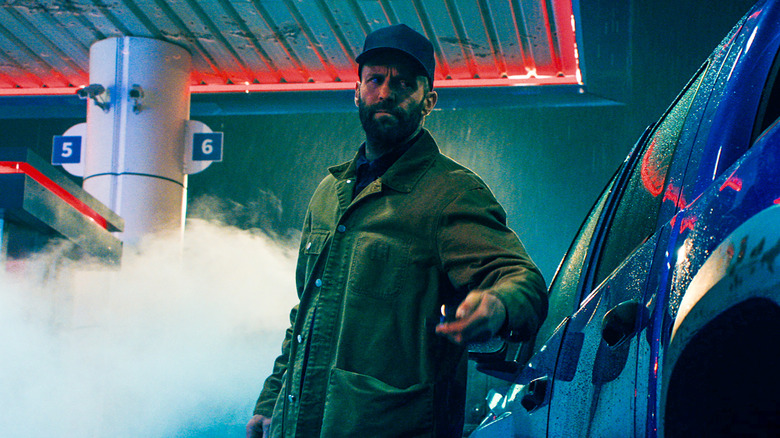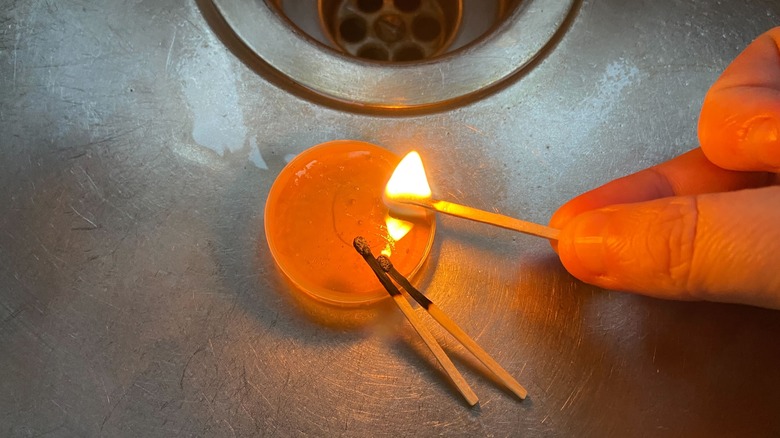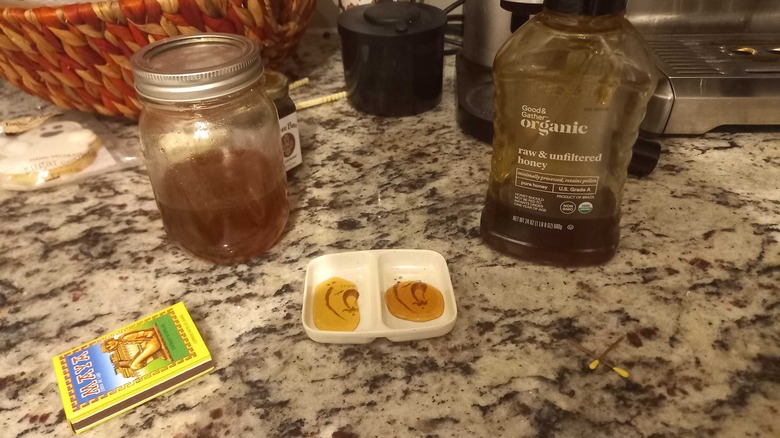Let's Fact Check The Most Ludicrous Moment In The Beekeeper Trailer
After watching the first trailer for the upcoming Jason Statham action thriller "The Beekeeper," I did what any reasonable person would do. I filled a plastic milk top to the brim with honey, put it in the sink (for safety), and tried to set the honey on fire.
For context, the climactic moment of the trailer sees Statham flinging a pot of honey at a chain-gun-wielding baddie to drench her in the sticky nectar by-product, then tossing a lighter at the spilled honey. Aforementioned baddie is enveloped in flames as the trailer cuts to another character explaining that honey is "flammable as f***."
Well, apparently no one told honey that it was supposed be "flammable as f***." After giving this trailer the "MythBusters" treatment, we can add "honey is natural napalm" to the list of things that Hollywood has lied to us about, along with "air vents are always large enough to crawl through" and "you can walk away from an explosion without flinching."
Experiment #1: British honey
The initial test was conducted using Co-op brand clear honey, described in the packaging as "a versatile honey ideal for use in cooking, baking, as a breakfast topping, in drinks, or simply spreading on toast." The materials further note that this is a "blend of non-EU honeys." As I'm sure our readers will already be aware, an investigation by the European Commission earlier this year called the reputation of British honey into question when it revealed that all 10 samples of honey imported to the EU from the UK failed authenticity tests. Rather than being comprised of pure honey, at least half of the samples were found to have been adulterated with cheap sugar syrups.
Lynne Ingram, master beekeeper at Wesley Cottage Bees in Somerset and founder of the Honey Authenticity Network UK, called the report "shocking," while noting that since Brexit took the UK out from under the EU's food regulation standards, "there is no proper enforcement or testing at the moment and people can get away with it very easily."
This detail is important because our research showed that the purity of honey can be tested by fire. The Scottish Bee Company recommends performing the "flame test" on honey to measure its purity: dip the tip of a matchstick in the honey, then strike the match as usual on the side of the matchbox. If it fizzles and fails to flame, your honey contains moisture and is impure. If the match lights despite the honey coating, you have pure honey in your pot.
To my dismay, my honey failed the matchstick test. It also failed to ignite when flames from a candle lighter and three different matches were held against the surface. Consumers, bee warned: Co-op's honey is not combat-ready.
Experiment #2: Pure red-white-and-blue American honey
The tainted reputation of British honey meant that further experimentation was required. Fortunately, intrepid /Film reporter Ryan Scott was on hand with not just one, but two samples of supposedly pure honey. One was some "country-ass" honey that had been received as a gift in a mason jar. The other was Good & Gather organic "raw & unfiltered honey" bought from Target. I will confess to having high hopes for both since, at this point, I was pretty invested in being able to successfully set some honey on fire. The Good & Gather honey in particular is labeled as U.S. Grade A, and claims to be "pure honey," which seemed promising.
Once again, though, our dreams were dashed. Ryan first tested a spoonful of each honey against an open flame, attempting to ignite it with a lighter as Mr. Statham does in the trailer for "The Beekeeper." The honey was unperturbed. The matchstick test was up next, and each of the matchsticks failed to light after being dipped in honey.
Since neither myself or Mr. Scott have immediate access to a beehive, it was unfortunately not possible to get some honey straight from the bee's teat, as it were. But since flammability is supposedly the test of pure honey, I turned to science to learn more.
Flammable? No. Combustible? Yes!
One of the golden rules of the internet is that if it's possible to set something on fire, there will be a video of someone setting it on fire. Sure enough, YouTuber Ludwig Bon Quirog y Migriño, aka Bon-Bon Quest, uploaded a video showing various ways to test the purity of honey, one of which involves holding it over an open flame. Of the two honey samples tested, one was found to be pure and began to burn by itself after approximately 10 seconds of contact with the lighter flame. So, honey can indeed fuel a flame, but probably not if you just fling a lighter at it like Statham does in the "Beekeeper" trailer. You would need to be standing close to a hopefully very patient enemy to pull it off, and even then you wouldn't get an instantly lethal conflagration.
Though pure honey is sometimes colloquially described as "flammable," the more accurate term would be "combustible." As explained by workplace safety company Human Focus, flammable materials are those that have a flash point (the temperature at which they will ignite immediately upon contact with an open flame) below 100 degrees Fahrenheit. Examples of flammable liquids include ethanol, kerosene, and acetone. The flash point of honey is around 200 degrees Fahrenheit, and it would therefore be classed as a combustible material, similar to diesel or formaldehyde.
So yes, unless Statham's honey is mixed with kerosene, "The Beekeeper" is lying to us for the sake of entertainment. But given that the first thing I did after seeing honey go up in flames in a movie trailer was try to start a honey fire in my kitchen, that's probably for the best. People aren't to be trusted.
"The Beekeeper" opens in theaters on January 12, 2024.


